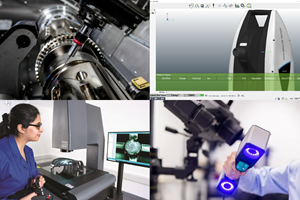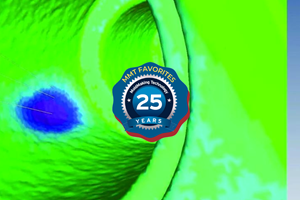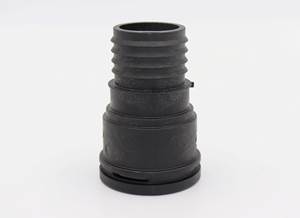CT Scanning Accelerates Corrections on Injection Molds
Industrial computed tomography scanning (CT scanning) is a quality-assurance technique that is making its way into mold shops for speedy adjustments and corrections on injection molds, but only if it is used correctly.
Computed tomography scanning, or CT scanning, is like having x-ray vision. One can see into a part and dimensionally measure features and structures without destroying the part while simultaneously taking numerous, accurate measurements.
Computed tomography scanning, or CT scanning, is like having x-ray vision.
CT scanning quickly provides moldmakers and molders with the ability to overlap actual scan data with that of the original CAD model, or the “perfect part,” showing user-defined pass or fail criteria, comparing actual values to nominal values, and displaying in graphics the out-of-tolerance variances in easy-to-see colors. The process can be used to reverse-engineer existing products and create files that, in turn, can generate tool paths for mold, die or fixture tooling.
If this technology is such a great thing to have, why don’t all moldmakers own a CT scanner to produce the “perfect mold” and ultimately have the mold produce the “perfect part?”
The most obvious reason is the high investment cost. Steffen Hachtel from F.&G. Hachtel GmbH & Co KG, a plastic injection molder based in Aalen, Germany, explains that a CT scanner costs between 300,000 and 600,000 euros, and annual maintenance costs amount to 10 to 15 percent of the initial investment. The company currently runs four GE scanners and one Nikon CT scanner. Despite the high cost, the most significant benefit of CT scanning for injection-molded parts can offset the high price tag in the long run. That is, CT scanning easily indicates the amount and location of any shrinkage and warpage that has occurred throughout the part, significantly accelerating tool qualification before production molding, especially for complex parts.
However, there is one caveat. Very often, parts are not accurate according to the drawing specs data, Hachtel says. Comparisons of the CT scan data with the original drawing show that massive deviations can occur, which might lead a moldmaker to believe that the mold is wrong, but that is not necessarily the case.
“If the final molded part does not conform to specs, people conclude that the mold was not designed and machined precisely, when in reality, the mold is often not to blame. The measurement alignment, drawing or data interpretation might be wrong. Additionally, the warpage is often not from the mold design but results from the chosen part geometry. The lesson here is that if CT scanning technology is not used correctly, it can lead to misinterpretations and wrong conclusions,” Hachtel says.
“The lesson here is that if CT scanning technology is not used correctly, it can lead to misinterpretations and wrong conclusions.”
Using CT scanning properly, drawing the appropriate conclusions and reaping all of its benefits requires knowledge of comparing CAD data with CT data and knowledge of shrinkage and deformation during the molding process and during de-molding.
Putting CT Scanning to Work: Measurement Comparisons and Evaluations
With so many obstacles to overcome, how can CT scanning be a blessing and not a curse? What does it take to use the technology in a way that actually lets a moldmaker increase accuracy and speed up the process? For Hachtel, it is many years of experience in the company’s own moldmaking facility and a high level of expertise in the injection molding process.
As early as 2008, Hachtel pioneered the first 3D-computed tomography method as a way of qualifying plastic components that were manufactured in-house and in combination with simulation methods to optimize mold design. Although it was initially treated with skepticism, expertise in industrial computed tomography is now highly valued, particularly when it is combined with the moldmaking activities of injection molders, moldmakers or end users. The company grew from one employee and one CT scanner to what is now eight employees and five CT scanners.
Sample components are almost exclusively qualified with CT scanning. “The voxel data models obtained from computed tomography and the CAD models of the component make it possible to make comparisons. Currently, this is our main piece of equipment for making tool optimizations,” Hachtel says.
CT scanning opens up opportunities to understand the complete process, from design to the end-use part, and it makes everything transparent. “You can also outsource CT scanning and then analyze the part and compare it to the CAD data in-house, keeping the intellectual property in-house, optimizing shrinkage and proving the reproducibility of the processes,” Hachtel says.
Hachtel also uses VG Studio Max software from Volume Graphics for the most critical measurement comparisons and evaluations. The software offers a corresponding module that makes it possible to compare nominal and actual values. A best-fit function is used to overlay CT and CAD data sets in any position in free space, making it possible to calculate deviations in advance. It is possible to question the alignment according to a drawing (as in the era of tactile measurement technology), and quite often it turns out not to be useful.
For first article inspection and quality control, the CT measuring data of the digitized components can be directly compared with the original CAD master data. Moldmakers can use such a full-surface comparison of the nominal and actual values to determine quickly whether the defined tolerance limits have been maintained or to control which areas of a component have been deformed.
The measured data and the CAD model are then imported into the inspection software VG Studio Max. After the alignment to the CAD coordinate system (reference point-system registration 3-2-1, Best-Fit), the software immediately visualizes any deviation using a color plot of the entire component surface, which permits quick, easy interpretation.
“It is important to compare the measured data with the CAD data and not with the drawing because very often, the drawings don’t take the whole process, the shrinkage or deformation during molding into consideration,” Hachtel says. “Capturing the actual contour is vital in moldmaking, as properly fitting items otherwise seem to come from molds that do not conform to the drawing specs, which compensate for shrinkage and deformation during the production process and de-molding.”
To align the scanned part with the CAD model, the VG Studio software has different segmentation tools, allowing data sets to be separated into different components, materials or regions of interest. Segmentation is the basis of many data-analysis tasks, making it a highly important functionality that helps users complete their tasks.
For Hachtel, regions of interest and best-fit alignment, where the average deviation between scanning and CAD is as little as possible, works well. Comparisons of nominal to actual values are visualized using false color rendering. For example, green represents areas within tolerance and red represents areas that are out of tolerance.
"In our opinion, it is illogical to measure all the dimensions (as this yields extremely long measurement protocols), and then compare them against dimensions that are within tolerance. This is an old-fashioned procedure,” Hachtel says. “Today’s comparisons of nominal and actual values that are available with CT scanning technology quickly and reliably show the component areas that are out of tolerance.”
He cites a car’s central bow or “main strut” as an example of a part that displayed deviations of 3 millimeters when the scanned data of the final part was compared to the drawing data, using the suggested alignment method in the drawing. “If you concentrated on the areas of interest, where the part had to fit in its final assembly and which in our case were the fittings, the deviation was only 0.2 millimeter, so the mold was good and no correction was needed. If you compared your CT data to the drawing and the given reference points, you might have thought it was necessary to re-design your mold, which, in fact, is not always the case. However, it is important that the moldmaker or mold designer optimize and analyze the part, not the customer, as analysis, assessment and design should be performed simultaneously.”
About the Author
Barbara Schulz
Barbara Schulz is Gardner Business Media’s European correspondent. She can be reached at bschulz@gardnerweb.com.
Related Content
Quality Control Technologies Geared for Injection Molds
These latest technology solutions, from noncontact gages to test probes and automated inspection systems, aim to minimize production risks and ensure optimal quality control practices for moldmaking.
Read MoreCT Scanning Helps Micro Molder Reduce Cost of First Article Inspections
CT scanning services performed by 3D ProScan, a division of NyproMold Inc. provides MTD Micro Molding with accurate, high-resolution internal and external measurements performed about seven times faster and at significant cost savings.
Read MoreVIDEO: Maintaining a Customer-Centric Culture
Progressive Components President Glenn Starkey talks about the importance of the customer and culture when developing technology solutions for the moldmaking industry.
Read MoreHow to Harness 3D Scanning for Mold Tool Repairs
3D scanning supports the repair of molds with no history, drawings or design files.
Read MoreRead Next
What’s Behind Germany’s Apprenticeship Success?
Germany’s apprenticeship approach has often been replicated by other countries, but the copy has rarely achieved the desired success. One of the secrets of its success lies in the country’s legacy of vocational education and the fact that “vocational” is not a bad word.
Read MoreAre You a Moldmaker Considering 3D Printing? Consider the 3D Printing Workshop at NPE2024
Presentations will cover 3D printing for mold tooling, material innovation, product development, bridge production and full-scale, high-volume additive manufacturing.
Read MoreHow to Use Strategic Planning Tools, Data to Manage the Human Side of Business
Q&A with Marion Wells, MMT EAB member and founder of Human Asset Management.
Read More

.png;width=700;quality=80)
.png;width=860)
.png;width=860)
.jpg;width=860)
.jpg;width=860)
.jpg;maxWidth=150;quality=70)

















.jpg;maxWidth=400;quality=70)


